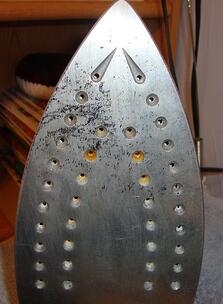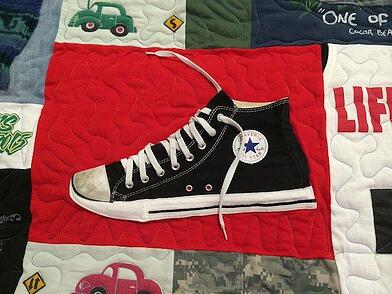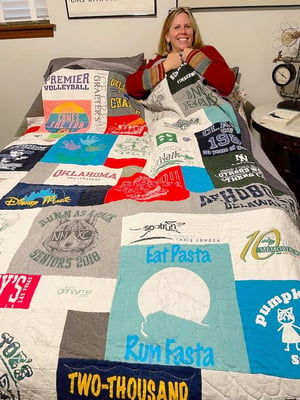10 Questions to Ask About a T-shirt Quilt Maker
- How long have they been in business?
- How many T-shirt quilts have they made?
- What type of T-shirt quilts are they making?
- Are they using iron on backing?
- What type of quilting are they doing on the T-shirt quilt?
- Is the quilt being sent out for quilting?
- How creative is the quilt maker?
- What quality of materials are they using?
- Is the home or shop smoke free/pet free?
- How long will it take to have your T-shirt quilt made?
4. Are They Using Iron-on Backing or Interfacing?
 Traditionally, quilt makers have been advised by the industry to utilize iron-on backing or interfacing when creating T-shirt quilts. This is a myth the quilting industry has kept alive. Why? Well, if quilt makers think they need iron on backing, they will buy it. The myth is kept alive to sell an unneeded product to quilt makers.
Traditionally, quilt makers have been advised by the industry to utilize iron-on backing or interfacing when creating T-shirt quilts. This is a myth the quilting industry has kept alive. Why? Well, if quilt makers think they need iron on backing, they will buy it. The myth is kept alive to sell an unneeded product to quilt makers.
A quilt maker does not have to use interfacing or iron-on backing. You can read why I think need iron-on backing is useless here.
If a quilt maker uses iron-on backing this is a clue for you. First, iron-on backing is a sign of inexperience. Second, it illustrates a quilt maker's fear to try new things. (Although we have been making T-shirts without interfacing since 1992. So, it's not all that new.) And third, it will make your quilt stiff.
Iron-on backing is unnecessary on the back of T-shirts. It's an added expense that will just make your quilt stiff. Ask potential quilt makers if they use iron-on backing or interfacing. If they do, consider removing them from your list of potential quilt makers.
5. What Type of Quilting Do They Do on Their Quilts?
Quilting holds the three layers of a quilt together. The three layers are the quilt top, the batting and the backing material. These three layers must be connected to make the quilt.
If there is no quilting or only two layers, this is not a quilt. It's a blanket. Here's an explanation of the differences between a quilt and a blanket. It's important to understand these difference. Whether you have a quilt or blanket made, it makes a difference. It will influence the quality, price and longevity of your T-shirt quilt or blanket.
There are two major things to understand about quilting. First, if the three layers of a quilt aren't connected or connected sparsely, the batting can bunch up and be lumpy. This is just no fun. Here's more about batting used in a T-shirt quilt.
Second is how the quilting will look on your quilt. Some companies use a simple standard overall pattern. It's fast, cheap and kind of boring. We think quilting should be fun and interesting. We quilt each block in our quilts with a different pattern. Read more about what great quilting looks like here.

Learn about quilting styles and methods so you know what you want. Then you can use this information in selecting your quilt maker.
In the photo here, you can see that the quilt on the right has very little quilting. The quilt on the right is quilted in the Too Cool style. Each block gets it own quilting pattern. Which one do you like best?
6. Is the Quilt Maker Sending Their Quilts Uut for Quilting?
 Some quilter makers only can do part of the quilting process. They must send out their quilts to be long-arm quilted. There are risks associated with your a quilter farming out your quilt for quilting. These risk include loss, indifference to your requests, and unknown environment.
Some quilter makers only can do part of the quilting process. They must send out their quilts to be long-arm quilted. There are risks associated with your a quilter farming out your quilt for quilting. These risk include loss, indifference to your requests, and unknown environment.
Ask potential quilt makers if they do their own quilting. If they don't, this is a clue they are not a professional. A clue about their lack of experience. And a clue they won't always have your T-shirts in their care. (This should scare you!)
7. How Creative Is the Quilt Maker?
 You don’t want a cookie cutter T-shirt quilt – they are just too boring. The more creative the individual, the more creative your quilt will be.
You don’t want a cookie cutter T-shirt quilt – they are just too boring. The more creative the individual, the more creative your quilt will be.
To judge creativity, look at photographs of a quilt maker's work. Here are some things to consider:
- Look for how they handle odd items. If there aren't any odd items, the quilt maker hasn't progressed beyond the basics.
 Are any T-shirt design cropped off? If so, this is not a good sign. All the designs on your T-shirts should be used in their entirety. A creative quilt maker will know how to do this.
Are any T-shirt design cropped off? If so, this is not a good sign. All the designs on your T-shirts should be used in their entirety. A creative quilt maker will know how to do this.- Look at the backs of a quilt maker's quilt. Is the quilting interesting and fun? Or is it repetitive? Do you like the quilt maker's style? If not, continue your search.
Here's an article about getting clues from a photo of a T-shirt quilt. This information can help you be a better detective in your search for a quilt maker.
8. What Quality of Materials Are They Using?
 Some quilter’s prices may seem very low. One reason they are low is because they are using low quality material. Low quality material can make even a nice quilt, less nice.
Some quilter’s prices may seem very low. One reason they are low is because they are using low quality material. Low quality material can make even a nice quilt, less nice.
Think about other areas in life where low quality materials are used. Sometimes, it just makes for a cheap item. A lower price T-shirt quilt is not always the best deal.
There are two materials that can effect the cost and quality of a quilt.
- The backing material.
The backing fabric should be 100% high quality quilter's cotton. Here's an article that explains about the backing material in more detail. - The batting.
There are two main types of batting that are used in quality T-shirt quilts. 100% cotton or 80% cotton/20% poly mix. The 80/20 is the better of the two. Anything made with 100% polyester batting should be avoided. Here's information about the types of batting quilt makers typically use.
9. Is the Mome or Shop Smoke Free?
This can be a personal choice. If you are not a smoker, having your quilt come back smelling like smoke is awful. So having a quilt made in a home of a smoker might be a deal breaker. The same for cats and perhaps dogs. If either smoking or pets would be an issue for you, ask about them up front.
10. How Long Will it Take to Have Your T-shirt Quilt Made?
 You don’t want to send your T-shirts to someone and then have to wait months or years to have your quilt returned.
You don’t want to send your T-shirts to someone and then have to wait months or years to have your quilt returned.
This happens! It happens when the person making your quilt isn't a professional. People who are not professionals have other jobs or duties that take priority over quilt making.
It can also happen when you agree to work with someone who doesn't know what they are doing. They get started on it the quilt and realize they have no idea what they are doing. So it gets set aside.  I have had customers who have had to retrieve their T-shirts 5 years later. It's not a good situation!
I have had customers who have had to retrieve their T-shirts 5 years later. It's not a good situation!
A reasonable turn around time is less than six weeks. Industry standard is 4 to 6 weeks. Before you give someone your T-shirts, ask when the quilt will be finished. After 8 weeks, I would start to pester your quilt maker.
A good quilt maker will state on their website what their turn around time is. They will also let you know if they become backed up and need to push out their due date. A good quilt maker will keep in touch with you.
Conclusion
 Before you send your T-shirts off to any quilt maker, make sure you know you will be getting back the quilt of your dreams. Having no T-shirt quilt at all is better than having a cheap piece of crap that leaves you broken-hearted.
Before you send your T-shirts off to any quilt maker, make sure you know you will be getting back the quilt of your dreams. Having no T-shirt quilt at all is better than having a cheap piece of crap that leaves you broken-hearted.
Take your time and do your research. You will be happier with your decision and your quilt.
Below we have a list of interview questions you can ask a potential quilt maker. You are welcome to print this out and share it.
Want to learn more about T-shirt quilts? Visit our Learning Center.
We have over 200 articles about all aspects of T-shirt quilts.
Interview Questions



 Any less than 3 years is a clue that they are a beginner. The length of time in business can correlate to a quilt maker's skill level. Making a great T-shirt quilts take practice. There are many things to learn about the T-shirt quilt making process.
Any less than 3 years is a clue that they are a beginner. The length of time in business can correlate to a quilt maker's skill level. Making a great T-shirt quilts take practice. There are many things to learn about the T-shirt quilt making process. 


